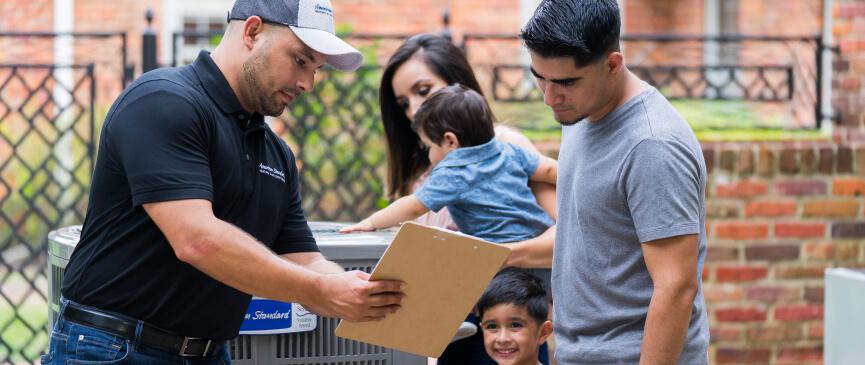What’s the Ideal Temperature for Sleep?
Spoiler alert: The ideal temperature is 65 degrees. Find out why.

By Tom Moor
Getting a good night’s sleep isn’t just about having a comfortable mattress or a quiet room – it’s also about finding the right temperature. A bedroom that’s too hot or too cold can make falling asleep and staying asleep difficult. In fact, sleep specialists, known as somnologists, say the temperature plays one of the biggest roles in how well we rest.
So, what exactly is the ideal temperature for sleep? Let’s break it down so you know what to set your thermostat to before heading to bed, along with some additional tips for creating a comfy bedroom at night.
Why temperature matters for sleep
Your body naturally cools down at night as part of its circadian rhythm. This drop in core temperature signals to your brain that it’s time to rest. If your room is too warm, your body may struggle to reach that cooler state, often leading to restlessness, sweating, or waking up during the night.
On the other hand, if your room is too cold, your body may find it difficult to maintain its core temperature, potentially causing disrupted sleep, shivering, and increased stress on your cardiovascular system. The sweet spot lies somewhere in the middle.
The best temperature for sleeping
So, what is the best temperature for sleeping? Most sleep experts recommend setting your thermostat at 60-67 °F at night. Within that range, 65 degrees is often considered the “ideal” temperature for many adults.
Here are a few factors that might influence where you fall in the nighttime temperature range:
- Age: Children and adults typically prefer cooler temperatures, while older adults may prefer warmer settings as their bodies become less efficient at regulating heat.
- Metabolism: People with a naturally faster metabolism often feel warmer and may prefer a cooler room.
- Health conditions: Issues like thyroid disorders, sleep apnea, or night sweats can change what temperature feels restful.
- Bedding: Heavy blankets and comforters hold heat, which means you might want to dial the thermostat down a few extra degrees or use a lighter blanket.
- Climate: If you live in a very hot or humid area, you might prefer keeping your system closer to the low 60s because high humidity can make it harder to cool down and feel comfortable.
- Weight: Body weight can influence sleep comfort, as people with higher body mass often retain more heat and may prefer cooler bedroom temperatures.
- Personal preference: Some people simply prefer to sleep in cooler or warmer conditions than others because they sleep better.
Once you find the temperature that works for you, try to keep it steady throughout the night.
How your thermostat helps you sleep better
Your thermostat can be a great tool for keeping your bedroom at the best temperature for sleep.
Programmable thermostats
Programmable thermostats allow you to set a schedule that automatically lowers the temperature when you go to bed and raises it again when you wake up. This ensures the nighttime temperature is always set right without you having to make automatic adjustments.
Smart thermostats
Smart thermostats also allow you to pre-set the temperature. But unlike traditional thermostats, they can learn your habits and sync with your phone, so you always come home (or head to bed) to the right temperature. And if you want it to be a little cooler on an especially muggy night, you can adjust the thermostat from your smartphone without even getting up!
Additional ways to keep your bedroom sleep-friendly
Beyond adjusting the thermostat, other small adjustments that can help you stay cool and drift off faster include:
- Upgrade your bedding and sleepwear: Lightweight sheets; natural fabrics like cotton, linen, silk, or bamboo; and breathable pajamas help your body release heat more easily.
- Keep the air moving: A ceiling fan or a small bedside fan circulates air, keeping the room feeling fresher while also producing steady background noise.
- Shut out daytime heat: Close blinds or invest in blackout curtains to prevent your room from heating up during the afternoon sun.
- Time your activities wisely: Intense exercise, alcohol, and heavy meals too close to bedtime all push your core temperature higher and delay sleep.
- Invest in your sleep setup: A quality mattress and supportive pillows not only improve comfort but also reduce tossing and turning that can generate body heat.
- Stick to a routine: Going to bed and waking up around the same time each day helps regulate your body’s internal clock.
Why does your bedroom still feel too hot or cold?
If you’ve adjusted your thermostat but your bedroom still doesn’t feel comfortable, your HVAC system may be at fault. A few common causes include:
Uneven cooling or heating
Uneven heating or cooling can be caused by poor insulation, blocked vents, or leaky ductwork. Additionally, thermostat placement, window drafts, and sun exposure can contribute to temperature imbalances.
Thermostat issues
A miscalibrated thermostat might not be reading your home’s temperature accurately. This can lead to your HVAC system running inefficiently which can cause comfort issues throughout your home.
Insulation problems
Drafty windows or poor attic insulation can allow heat to escape in the winter and enter during the summer.
System efficiency
An older HVAC system may struggle to keep up, especially during extreme weather. If this is the case, it might be worth considering installing a new system to lower energy bills and improve comfort.
If you notice any of these issues, contact an American Standard® dealer for a system check-up.
Why humidity matters for sleep
Temperature isn’t the only factor that influences sleep quality; humidity plays a big role, too.
When the air is too humid in summer, sweat can’t evaporate as easily, leaving you sticky and restless. Even though air conditioners help remove some moisture, older or undersized units may leave your room feeling damp. A portable dehumidifier can help in a single bedroom, while a whole-home system helps balance humidity throughout the house.
Meanwhile, winter often brings air that’s too dry. Low humidity can dry out your throat, nose, and skin, sometimes making it harder to breathe comfortably at night. Adding moisture back with a humidifier – with a small tabletop model or a system that treats the whole home – helps maintain healthier, more breathable air for sleep.
Aim for a relative humidity level between 30% and 50%. Keeping your bedroom within that humidity range helps you breathe easier, reduces discomfort at night, and keeps your room more comfortable.
Sleep better with the right home comfort solutions
Finding the right sleep temperature shouldn’t be a nightly struggle. Whether you need a smart thermostat, a humidity control system, or a new HVAC setup, an American Standard dealer can help create the perfect environment for rest. With expert guidance and reliable installation, you’ll have peace of mind knowing your comfort is in trusted hands. Talk to your local American Standard dealer today!
Author: Tom Moor
Expert review by Caitlin Butler, Product Manager, Thermostats and Home App
Related articles



